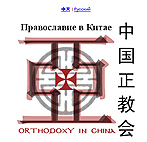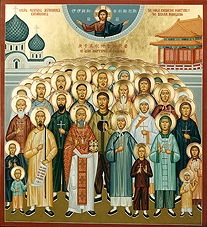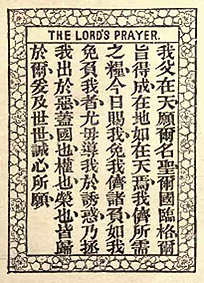Orthodoxy in China
(
10.03.2007
)
 While the presence of Western Christian Churches in China is a well-known fact, many people are not aware that the Orthodox Church has also been present in that country for more than 300 years. Orthodoxy reached China with the eastern expansion of the Russian empire across the Siberian Far East in 1651, more than a century earlier than the first Protestant missionaries. At around the same time in 1644, the Ming dynasty was overthrown in China by the Manchurians who introduced the Qing dynasty which lasted until the Nationalist revolt of 1911. Intermittent border skirmishes in the Amur River area between troops of the Qing Emperor and the Czar resulted in some Russians being taken prisoner. A priest by the name of Maxim Leontiev was among the prisoners taken in 1685 to Beijing. The Russo-Chinese accord of Nerchinsk in 1690 settled disputes but some of the released prisoners decided to stay in China as naturalized citizens. The Kangxi (Kang Hsi) Emperor gave a Guandi (Kwan Ti, the god of war) temple to them as a temporary place of worship in Beijing, and the Orthodox named it the Hagia Sophia Church. An icon of St Nicholas the Wonderworker was placed in the church, which was subsequently renamed the Church of the Dormition. The Emperor also gave Father Leontiev the title of an imperial official of the seventh rank.
While the presence of Western Christian Churches in China is a well-known fact, many people are not aware that the Orthodox Church has also been present in that country for more than 300 years. Orthodoxy reached China with the eastern expansion of the Russian empire across the Siberian Far East in 1651, more than a century earlier than the first Protestant missionaries. At around the same time in 1644, the Ming dynasty was overthrown in China by the Manchurians who introduced the Qing dynasty which lasted until the Nationalist revolt of 1911. Intermittent border skirmishes in the Amur River area between troops of the Qing Emperor and the Czar resulted in some Russians being taken prisoner. A priest by the name of Maxim Leontiev was among the prisoners taken in 1685 to Beijing. The Russo-Chinese accord of Nerchinsk in 1690 settled disputes but some of the released prisoners decided to stay in China as naturalized citizens. The Kangxi (Kang Hsi) Emperor gave a Guandi (Kwan Ti, the god of war) temple to them as a temporary place of worship in Beijing, and the Orthodox named it the Hagia Sophia Church. An icon of St Nicholas the Wonderworker was placed in the church, which was subsequently renamed the Church of the Dormition. The Emperor also gave Father Leontiev the title of an imperial official of the seventh rank.
Thus the seed of the Russian Ecclesiastical Mission has been planted on Chinese soil. In the 200 years leading up to the Boxer Rebellion of 1900, the Mission took in only a small number of indigenous Chinese converts, mostly through inter-marriage with the Albazinians (descendants of the Russian prisoners). This stood in stark contrast with active missionary efforts by rival Catholic and Protestant missionaries.
During the Boxer Rebellion of 1900, or the Yihetuan Movement as the Chinese called the uprising, over 200 Chinese and Albazinians together with their archpastor St Mitrophan gave their lives up for the Christian faith in Beijing. Albazinians at this time have pretty much assimulated with the local population after two centuries of cohabitation. Their outward appearance is not much different from the majority Han Chinese population even though ethnically they consider themselves of Russian descent.
The Orthodox population swelled in the 20th century in China, mostly due to the influx of white Russians. At the same time, the Boxer uprising had not stopped the blood of the Martyrs from bringing forth a new generation of Chinese believers. Archimandrite Innokenti Figurovsky, who in 1902 became the first Bishop of Beijing, initiated translations of liturgical and catechetical Orthodox material for the first time into spoken Chinese called guanhua.
This was considered the golden era of Orthodoxy in China, with many churches being built. Unfortunately, most of the Russians fled China when the Communists took over in 1949. Some returned back to Russia but many others immigrated to Australia or America.
The famous St John, who was Archbishop of Shanghai, was one of the last to leave when the Communists took over and eventually settled in California. Also, Fr Elias Wen, who was the rector of the Church dedicated to the Surety of Sinners Icon of the Theotokos in Shanghai fled to Hong Kong and eventually immigrated to San Francisco. Also, the priest Michael Wang, and protodeacon Evangelos Lu stayed behind in Shanghai and suffered much through the Cultural Revolution (1966-76). They have likewise reached an old age and have withdrawn from active clerical involvement as there are no functional Orthodox Churches in Shanghai. Another protopriest Michael Li, also originally of Shanghai, immigrated to Australia and serves as the spiritual father of Russian-Chinese Orthodox Missionary Society of Sydney.
The Orthodox Church in China was given a status of autonomy by the Moscow Patriarchate in 1956 and had two Chinese bishops, several priests and possibly up to 20,000 faithful in the early 1960s. But it has never fully recovered from the turmoils of the "cultural revolution" of the 1960s and its antireligious policies. The Cultural Revolution destroyed most of the Church buildings and many believers were persecuted. Church life was practically eliminated and the believers have to resort to reader services in private homes to continue living their faith.
In December 2004, the last Chinese Orthodox priest living in China, Father Alexander Du Lifu, passed away in Beijing at the age of 80. He did never manage to get permission from the government to open a church in Beijing: the authorities argued that the community (about 300 faithful) was too tiny. However, there are efforts from several Orthodox Churches to revive Orthodox life in China, and a few Chinese students are reported to be currently training in Russian theological schools. According to estimates by Father Dionisy Pozdnyaev, who is in charge of Chinese affairs at the Department of External Relations of the Moscow Patriarchate, there are some 13,000 Orthodox faithful living in China. There are parishes - without clergy - in Xinjiang, in Inner Mongolia and in Harbin, where the Russian church building is a local landmark. In recent years, the Moscow Patriarchate has been quite active, including attempts to convince the Chinese government to register the Church, but its small size seems to present an obstacle. The Ecumenical Patriarchate (Constantinople) has established a diocese in Hong Kong - which is now part of Chinese territory - in 1996, serving South Asia and the Far East. Moreover, priests of the Russian Orthodox Church Outside Russia have also been regular visitors to the Chinese mainland. Those visiting priests have performed baptisms and celebrated liturgies for scattered communities of believers.
Efforts by non-indigenous priests have been hampered, including the recent deportation of an Orthodox priest who was secretly crossing the border between serving the spiritual needs of the Orthodox Faithful in Xinjiang in the western frontiers of China in December 2003.
The Chinese government is usually flexible with small group prayers in private homes, but they will start noticing if there are more than a handful gathering together. Visiting priests usually have to work within the supervision of the State Administration of Religious Affairs if they do not wish to encounter any obstacles, and for the most are only allowed to hold services for foreign compatriots working or residing in China. Such services are normally held in an embassy and are off limit to Chinese believers. The Chinese seminarians in the Russian seminaries do hope to return back to China to serve the Orthodox faithful there. This is a sensitive issue and requires the blessing of the Chinese goverment and their future is uncertain.
The Chinese government has been seen as more accomodating in recent years including allowing a hieromonk from Russia to visit the Pokrov Church in Harbin to hear confessions in both Russian and Chinese in July 2004, and also the August 2004 visit by Russian Bishop Mark to Beijing at the official invitation of local religious leaders and the State Administration of Religious Affairs.
Vladivostok Diocese has a creative missionary endeavor by actually allowing its church to serve as a one of the tourist sites for Chinese tourists visiting the city. The church has prepared an explanation of the Orthodox Church and its divine services in Chinese which is given to the tour guides to explain to the visitors, and at the end of the tour, the tourists actually get to light a candle in front of an icon of the Chinese Martyrs. The Russian president Vladimir Putin, for his part, brought before the Church Council the issue about the conversion to Orthodoxy of the Chinese who live and work in Russia.
 Attempts to revive Orthodoxy in China also take place in virtual space. An Orthodox believer of Chinese background living in the United States, Mitrophan Chin, is the webmaster of the website Orthodoxy in China (http://orthodox.cn), which was launched in Spring 2004. Orthodox.cn is created to be the portal of everything you will ever want to know concerning Orthodoxy as it developed in China and its environs, and especially where it is today and where it will be tomorrow. Catechetical literature and liturgical texts in classical and modern Chinese are gathered here for easy access for anyone interested in learning more of what Orthodoxy have to offer. Links to various Internet resources and Chinese Orthodox discussion boards are also provided to take advantage of the strength of the Internet in providing a wealth of information and exchange of ideas which no one site can provide. News articles related to Chinese Orthodoxy from Russian language media are translated into English and disseminated to keep the international English-speaking community in the loop concerning missionary activity made from the Russian Orthodox part of the world.
Attempts to revive Orthodoxy in China also take place in virtual space. An Orthodox believer of Chinese background living in the United States, Mitrophan Chin, is the webmaster of the website Orthodoxy in China (http://orthodox.cn), which was launched in Spring 2004. Orthodox.cn is created to be the portal of everything you will ever want to know concerning Orthodoxy as it developed in China and its environs, and especially where it is today and where it will be tomorrow. Catechetical literature and liturgical texts in classical and modern Chinese are gathered here for easy access for anyone interested in learning more of what Orthodoxy have to offer. Links to various Internet resources and Chinese Orthodox discussion boards are also provided to take advantage of the strength of the Internet in providing a wealth of information and exchange of ideas which no one site can provide. News articles related to Chinese Orthodoxy from Russian language media are translated into English and disseminated to keep the international English-speaking community in the loop concerning missionary activity made from the Russian Orthodox part of the world.
Currently, an online library of most of the extant classical Chinese Orthodox text that were produced in the 19th and early 20th century Russian Ecclesiastical Mission in China have been scanned in and being made available for free distribution via the web, which is the most economical and quickest way for those in China to get a personal copy of these rare historical texts. More recent Chinese translations suitable for the younger Chinese generation have also been made available online for the daily prayers with various canons and akathist plus the divine liturgy of St John Chrysostom. Most of this freely distributable material can be burned onto CD upon request for those in China without convenient Internet access, and they are encouraged to copy and share with family and friends.
A Hong Kong Protestant who did preliminary translation of the Prologue of Ohrid, has passed the torch to a Chinese Orthodox convert currently living in Romania.
Most Orthodox believers that are online are mostly converts and are usually self-motivated in seeking out the truth. They usually post anonymously to various online religous message boards to ask questions about the Orthodox faith. In the physical world, many times they would be drawn by the beauty of some of the restored Orthodox churches in China and would travel to visit such former churches like the St Sophia in Harbin or they may be curious and go seek out the existence of any former Orthodox church buildings that may have survived the destruction caused by the Cultural Revolution and ask around if there are any cradle Orthodox believers in the vicinity. Since mainstream Chinese media lacks coverage of Orthodox concerns, the web site also provides a much needed international and domestic Orthodox newsfeed in Chinese.
The parish website of Holy Trinity Orthodox Church in Taiwan is also in Chinese, but uses traditional Chinese characters which are different from what is taught in mainland China which uses simplified characters, introduced by the Communist government to combat illiteracy among the vast Chinese population. The Holy Trinity parish is under the pastoral care of the Metropolitanate of Hong Kong and South East Asia.
One of the next projects includes the Chinese translation from the original Russian accounts of the 222 confessors and martyrs of the Chinese Orthodox Church who fell victim in Beijing in 1900, drawn from the archives and first published in the January 2000 issue of Chinese Messenger (Kitajskij Blagovestnik) (http://www.chinese.orthodoxy.ru), the official Russian language magazine of the Study Group on Orthodox Affairs in China organized by Department for external church relations of Moscow Patriarchate. These accounts have been recently translated for the first time into English and can be read at http://www.orthodox.cn/history/martyrs/.
Source: Religioscope, 23 Oct 2004
 While the presence of Western Christian Churches in China is a well-known fact, many people are not aware that the Orthodox Church has also been present in that country for more than 300 years. Orthodoxy reached
While the presence of Western Christian Churches in China is a well-known fact, many people are not aware that the Orthodox Church has also been present in that country for more than 300 years. Orthodoxy reached 
 Attempts to revive Orthodoxy in
Attempts to revive Orthodoxy in